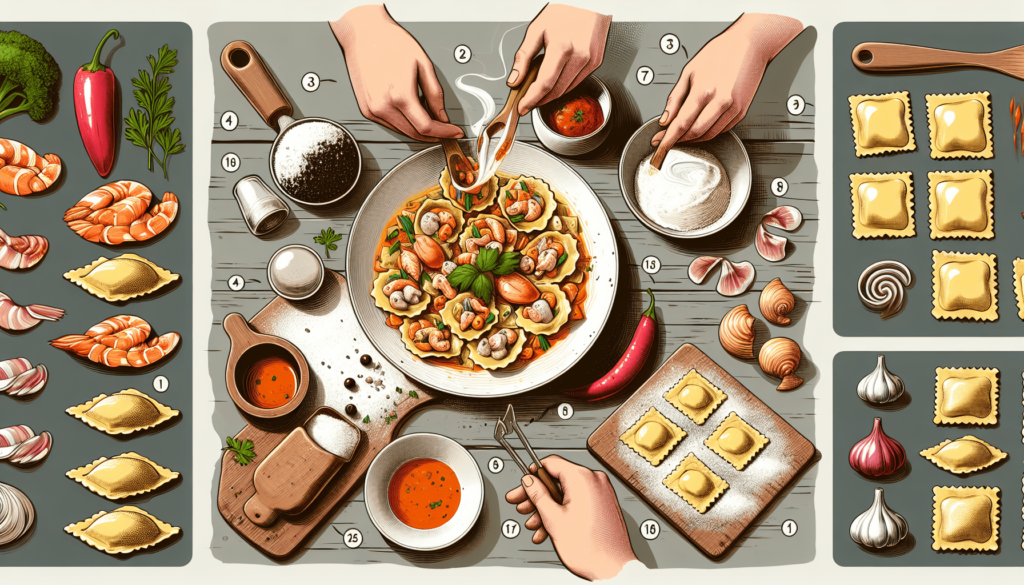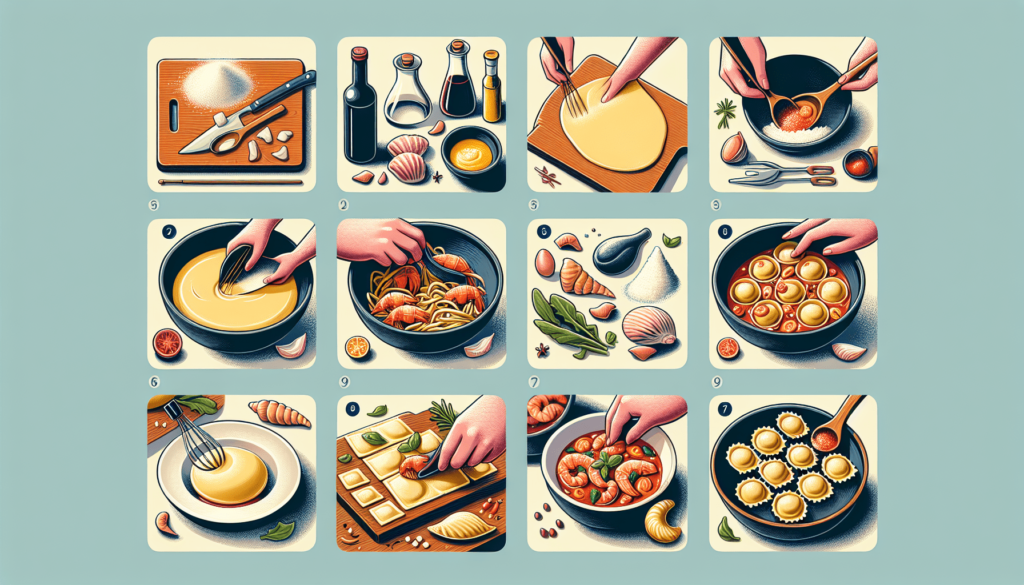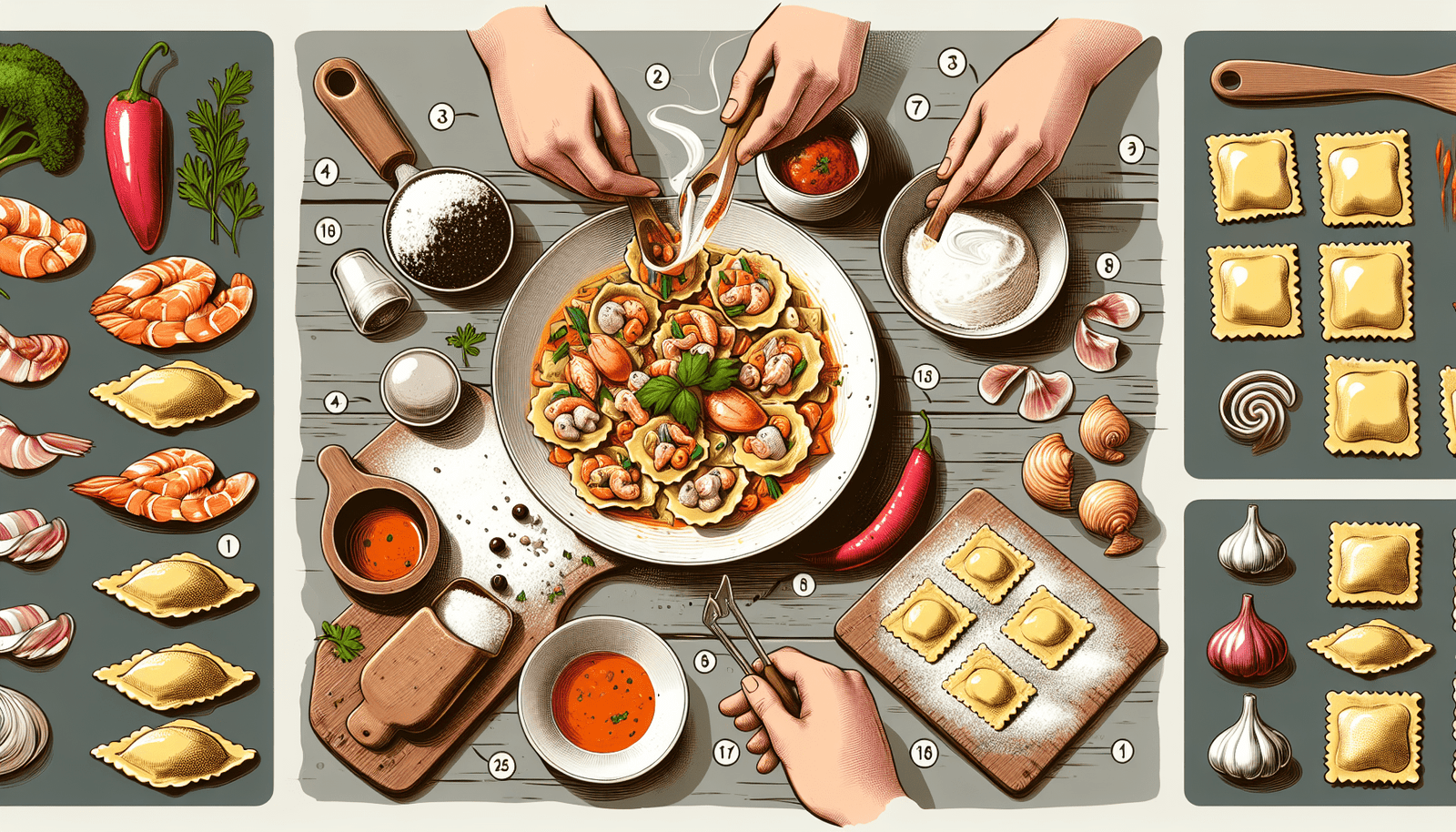Are you a fan of seafood? Do you enjoy exploring new recipes and flavors? If so, then get ready to tantalize your taste buds with our mouthwatering seafood ravioli recipe. This delectable dish combines the best of both worlds – the richness of fresh seafood and the comforting texture of homemade pasta. With a blend of succulent shrimp, delicate crabmeat, and flavorful herbs, each bite is a delightful burst of flavor. So, roll up your sleeves, grab your apron, and let’s dive into the world of seafood ravioli!
Ingredients
To make delicious seafood ravioli, you will need the following ingredients:
Seafood
Fresh seafood is the star of this recipe. You can use a combination of shrimp, scallops, or any other seafood of your choice. Make sure the seafood is cleaned and deveined before cooking.
Ravioli Wrappers
You will need store-bought or homemade ravioli wrappers to encase the seafood filling. These thin pasta sheets provide the perfect texture for your ravioli.
Onion
Chop a fresh onion to add a flavorful base to your filling. The onion will complement the seafood and enhance its taste.
Garlic
Garlic is a must-have ingredient that adds a robust and aromatic touch to any dish. Chop or mince the garlic cloves for sautéing in the filling and the sauce.
White Wine
White wine adds a sophisticated flavor to your ravioli. It helps deglaze the pan and reduce the seafood filling sauce to a rich consistency.
Heavy Cream
To create a creamy and luscious filling, you will need heavy cream. It adds richness and smoothness to the seafood mixture.
Parmesan Cheese
Parmesan cheese is a staple in Italian cuisine and adds a salty and nutty flavor. Grate or finely shred the cheese to incorporate into the filling and as a garnish.
Fresh Parsley
Fresh parsley adds a pop of color and freshness to the dish. It can be used both in the filling and as a garnish.
Salt
Salt is a crucial seasoning ingredient that enhances the flavors of all the other ingredients. Use it to taste throughout the cooking process.
Pepper
Freshly ground black pepper adds a subtle heat and earthy flavor to your seafood ravioli. Adjust the amount to suit your taste preferences.
Preparing the Seafood
Before you start with the filling, you need to prepare the seafood properly. Follow these steps:
Cleaning and Deveining the Shrimp
If you’re using shrimp, make sure they are properly cleaned and deveined. Remove the shells and tails, and use a small knife or shrimp deveiner to carefully remove the dark vein running along the back of each shrimp.
Preparing the Scallops
If you have chosen scallops for your seafood ravioli, gently rinse them under cold water to remove any debris. Pat them dry with a paper towel, and remove any tough side muscles if necessary.
Cooking the Seafood
Once the seafood is cleaned and prepared, you can cook it according to your preference. You can sauté the shrimp and scallops in a pan with a little oil for a few minutes until they turn pink and opaque. Set the cooked seafood aside while you make the filling.

Making the Filling
The filling is the heart of your seafood ravioli. Here’s how you can make it:
Chopping the Onion and Garlic
Finely chop the onion and mince the garlic cloves. The smaller the pieces, the better they will blend into the filling.
Sautéing the Onion and Garlic
Heat some oil in a pan over medium heat and sauté the chopped onion and minced garlic until they become soft and translucent. This step adds depth of flavor to your filling.
Adding the Seafood to the Pan
Once the onion and garlic are cooked, add the cooked seafood to the pan. Mix everything together to combine the flavors.
Deglazing with White Wine
Pour in a generous splash of white wine to deglaze the pan. Scrape up any browned bits from the bottom of the pan to infuse the sauce with extra flavor.
Reducing the Wine
Allow the white wine to simmer and reduce for a few minutes until it thickens slightly. The reduction will intensify the flavors of the wine in the filling.
Adding Cream and Parmesan
Next, pour in the heavy cream and add grated or shredded Parmesan cheese to the pan. Stir everything together until the cheese melts and the cream incorporates into a creamy sauce.
Simmering and Seasoning
Let the filling simmer gently for a few minutes to allow the flavors to meld together. Taste and adjust the seasoning with salt and pepper according to your preferences.
Cooling the Filling
Once the filling has simmered and is well-seasoned, remove it from the heat and allow it to cool completely before assembling the ravioli. This will make it easier to handle during the assembly process.
Assembling the Ravioli
Now that you have made the filling, it’s time to assemble your ravioli. Follow these steps:
Laying out the Ravioli Wrappers
On a clean and lightly floured surface, lay out the ravioli wrappers. Arrange them in a single layer, making sure they do not overlap.
Adding the Seafood Filling
Using a spoon or a small cookie scoop, place a dollop of the cooled seafood filling onto the center of each ravioli wrapper. Be careful not to overfill them, as it may cause the ravioli to burst during cooking.
Sealing the Ravioli
To seal the ravioli, lightly dampen the edges of each wrapper with water using your fingertip or a pastry brush. Fold the wrapper in half to form a triangle, enclosing the filling. Press the edges firmly to seal, ensuring no air pockets remain.

Cooking the Ravioli
Once your ravioli is assembled, it’s time to cook them to perfection:
Boiling a Pot of Water
Bring a large pot of salted water to a rolling boil. The salt will enhance the flavor of the ravioli as they cook.
Adding the Ravioli
Carefully drop the ravioli into the boiling water, ensuring they are not overcrowded. Cook them in batches if necessary to maintain an even cooking temperature.
Preparing the Sauce
While the ravioli are cooking, you can prepare a flavorful sauce to complement your seafood-filled pasta pillows:
Melting Butter in a Saucepan
In a separate saucepan, melt some butter over medium heat. Butter adds richness and a silky texture to the sauce.
Adding Minced Garlic
Once the butter has melted, add minced garlic to the saucepan. Cook until the garlic becomes fragrant, infusing the butter with its aromatic flavor.
Cooking until Fragrant
Continue cooking the garlic for a minute or two until it becomes lightly golden. Be careful not to burn it, as it can become bitter.
Pouring in White Wine
Pour in a generous amount of white wine, which will bring brightness and acidity to the sauce. Stir to combine and bring the mixture to a simmer.
Simmering and Reducing the Sauce
Allow the sauce to simmer gently until it reduces and thickens slightly. This will concentrate the flavors and create a delicious accompaniment to the seafood ravioli.
Serving the Seafood Ravioli
It’s time to bring everything together and serve your delectable seafood ravioli:
Draining the Cooked Ravioli
Using a slotted spoon, carefully remove the cooked ravioli from the boiling water and drain them well. Be gentle to prevent them from breaking.
Tossing the Ravioli in the Sauce
Transfer the drained ravioli to the saucepan with the prepared sauce. Gently toss the ravioli in the sauce, ensuring each piece is coated evenly.
Garnishing with Parsley and Parmesan
Sprinkle some freshly chopped parsley and grated Parmesan cheese over the sauced ravioli. These garnishes add freshness and an extra layer of flavor.
Seasoning with Salt and Pepper
Taste the completed dish and season with salt and pepper to your liking. Remember, a little goes a long way, so add them slowly and adjust as needed.
Plating and Serving
Divide the seafood ravioli onto plates or shallow bowls. Arrange them beautifully, allowing the vibrant colors and enticing aromas to entice your taste buds.
Tips and Variations
Here are some tips and variations you can try with your seafood ravioli recipe:
Adding Vegetables to the Filling
To add more texture and variety, consider incorporating diced vegetables such as bell peppers, spinach, or mushrooms into the seafood filling. Sauté them with the onion and garlic before adding the seafood.
Using Different Types of Seafood
Feel free to experiment with different types of seafood in your ravioli. You can try combinations like lobster, crab, or even fish. Just ensure they are cooked properly and complement each other in both flavor and texture.
Making a Tomato-Based Sauce Instead of White Wine Sauce
If you prefer a tomato-based sauce over a white wine sauce, you can prepare a simple marinara sauce or a creamy tomato sauce to accompany your seafood ravioli. Just substitute the white wine and cream in the sauce with canned or fresh tomatoes.
Storage and Reheating
If you happen to have any leftover seafood ravioli, here’s how you can store and reheat them:
Storing Leftover Ravioli
Place any remaining ravioli in an airtight container or zip-top bag. Store them in the refrigerator for up to three days. Make sure the ravioli are cooled completely before refrigerating to prevent the filling from spoiling.
Reheating the Ravioli
To reheat the ravioli, bring a pot of lightly salted water to a boil. Drop the refrigerated ravioli into the boiling water and cook for a few minutes until heated through. Drain and serve as desired.
Conclusion
Seafood ravioli is a delightful dish that combines the freshness of the ocean with the comforting flavors of pasta. With this comprehensive guide, you now have everything you need to create delectable seafood-filled ravioli from scratch. Whether you enjoy them with a white wine sauce or a tangy marinara, these ravioli are sure to impress your guests and satisfy your cravings. So grab your apron, gather the ingredients, and let the culinary adventure begin!


